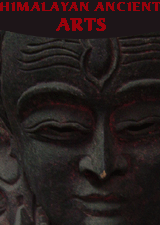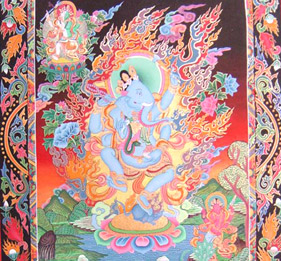Shop
By Type |
 |
|
|
|
|
|
|
|
|
|
|
|
|
|
|
|
|
|
|
|
|
|
|
|
|
|
|
|
|
|
|
|
|
|
|
|
|
|
|
|
|
|
|
|
|
|
|
|
|
|
|
|
|
|
|
|
|
|
|
|
|
 |
 |
Travel Packages  |
 |
 |
Newsletter |
 |
|
|
 |
|
 |
|
 |
|
 |
|
 |
|
 |
|
 |
|
 |
|
|
|
|
Newari Thangka/Thanka Paintings are one of the most popular Thangka/Thanka Paintings. We offer a wonderful and large collection of Thangka Paintings ever found on online. In this page you will be offered the excellent collection of Newari Thangka Painting. All our Newari Thangka Paintings come in different sizes, quality and price ranges. Our Thangka Paintings are made of cotton, gold paint, and different paints and have served as objects of meditation and ritual ceremony item in altar or temple in many part of the world. All our Newari Thangka Paintings are painted by the Newari artisans of Nepal , who have been in Thangka Painting business for generations. HimalayanMart is a Online Gallery of Thangka Paintings painted in the traditional style of Nepal and Tibet on canvas and Silk Mounted or Silk brocaded. With the collection of more than 500 Thangka Paintings in a single web site, www.himalayanmart.com is undoubtedly the largest Online Thangka Paintings Gallery.
|
| |
The best-known genre of pictorial art in Nepal is the painting on cotton cloth called Pata in Sanskrit, Paubha in Newari and Thangka in Tibetan. A large number of temple banners of this kind appear abruptly in the 14th century and the fact that their style and format is comparatively sophisticated and uniform suggests that they represent the continuation of an earlier tradition that is not represented by any surviving examples.
The 14th century Paubhas are stylistically close to the earlier manuscript illuminations. Rules of symmetry and frontlet - figures always face out of the painting - were inviolable, and the basic scheme of iconic Paubhas remained entirely valid thereafter, at least for the representation of benign deities: a central large figure occupies an ornate frame, surrounded by much smaller subsidiary figures. Mandalas and depictions of wrathful deities required some amendment to these rules, though symmetry and frontlet were always maintained. The composition of a Paubha that depicts a Mandala is inevitably dictated by the geometric pattern of the Mandala itself, and the principal, central figure of a Mandala is usually much the same size as the acolytes and subsidiary figures. In paintings of wrathful deities, the background is often dominated by a flaming red aureole ( Prabha ). Most Paubhas contain a register of ancillary deities at the top, and many include portraits of the artist's patrons at the bottom, though painters always remained anonymous. When natural objects appear in these paintings, they are used as...........................................................More>>>
|
|
 |
| |
The Newari Thangka Paintings shown below are the ones we found fit to add to our Thangka Paintings collection. Here in this page you can quickly and easily browse a variety of Newari Thangka Paintings for online sale. Beside online sale we also accept special request (any design, size, and quantity) of Newari Thangka Paintings from our customers. Please Contact Us for detail. |
| ONLINE COLLECTION OF NEWARI THANKA PAINTINGS |
|
|
| |
| About Newari Thangka Painting or Paubha: |
NEWARI THANGKA PAINTING : PAUBHA
The best-known genre of pictorial art in Nepal is the painting on cotton cloth called Pata in Sanskirt, Paubha in Newari and Thangka in Tibetan. A large number of temple banners of this kind appear abruptly in the 14th century and the fact that their style and format is comparatively sophisticated and uniform suggests that they represent the continuation of an earlier tradition that is not represented by any surviving examples.
The 14th century Paubhas are stylistically close to the earlier manuscript illuminations. Rules of symmetry and frontlet - figures always face out of the painting - were inviolable, and the basic scheme of iconic Paubhas remained entirely valid thereafter, at least for the representation of benign deities: a central large figure occupies an ornate frame, surrounded by much smaller subsidiary figures. Mandalas and depictions of wrathful deities required some amendment to these rules, though symmetry and frontlet were always maintained. The composition of a Paubha that depicts a Mandala is inevitably dictated by the geometric pattern of the Mandala itself, and the principal, central figure of a Mandala is usually much the same size as the acolytes and subsidiary figures. In paintings of wrathful deities, the background is often dominated by a flaming red aureole ( Prabha ). Most Paubhas contain a register of ancillary deities at the top, and many include portraits of the artist's patrons at the bottom, though painters always remained anonymous. When natural objects appear in these paintings, they are used as symbols and are not depicted naturalistically. For example, the shapes and colors of the lotus flower vary enormously, though artists must have been familiar with its natural appearance.
The Newar Paubha tended to use rather coarser cloth than the Tibetan Thangka , but in both cases the cloth was prepared to receive the paint with a mixture of chalk and glue. Colors, mostly derived from mineral sources, were also mixed with glue, and the finished painting was varnished with a mixture of egg-white and water. The work of Nepali artists is dominated by a deep rich red, supplemented and enlivened by bright blues, greens and gold. Only primary colors were used. The earliest dated example, in Los Angeles Country Museum , is from 1367, but Buddhist monasteries throughout the kingdom invariably posses a stock of such paintings of varying antiquity but remarkable stylistic conformity. For a few days each summer, usually between mid-July and mid-August, several Viharas in Lalitpur and Kathmandu display their Paubhas for community worship.
|
| |
|
| |
 |
|
 |
| |
|
|
| |
| |
|
|
 My
Shopping Basket My
Shopping Basket |
 |
| |
 Best
Seller Best
Seller |
 |
 |
 |
|
Grape Pashmina Shawl |
| Price: US$
71.43 |
|
|
|
| |
 Start
with your budget Start
with your budget |
 |
|
|
| |
 Tell
a friend Tell
a friend |
 |
Tell a friend and win exciting gifts...
Click here
to learn more. |
 |
 |
 |
 |
 |
 |
 |
| |
 |
|